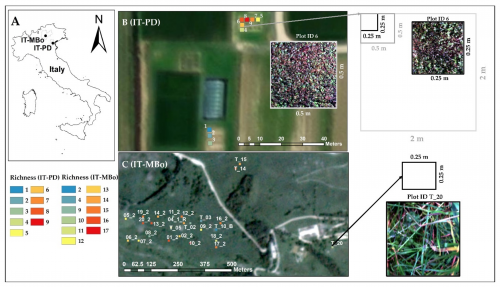Biodiversity and ecosystem functions provide crucial ecosystem services for human well-being, but changes in human activities have accelerated biodiversity loss. To address this decline, efficient methods and tools are needed to monitor biodiversity across spatial scales from the leaf level to the canopy, ecosystem, and global scales.
In that spirit, a SHOWCASE paper examined the use of high-resolution hyperspectral images to estimate α-diversity in grassland ecosystems. It surveyed grassland species composition and canopy hyperspectral data at two grassland sites in Italy: a species-rich semi-natural grassland and an artificially established grassland with a species-poor mixture. The researchers investigated the relationship between biodiversity indices and optical diversity metrics and found that while species richness could be estimated by optical diversity metrics at the species-poor site, it was more challenging to estimate biodiversity indices accurately in the species-rich site due to the higher number of species and strong canopy spatial heterogeneity.
Despite these limitations, the study confirmed the ability of spectral proxies to detect grassland α-diversity in man-made grassland ecosystems and provided insights into the optimal optical pixel size for different types of grasslands.
Read the full paper here.
Photo: A) Location of the sample plots in both study areas (IT-PD and IT-MBo). (B) The IT-PD plots (n = 9) are located at the experimental farm of the University of Padova (Legnaro, Italy). (C) IT-MBo plots (n = 25) are located in the natural grassland ecosystem in the Italian Alps (Monte Bondone, Trento, Italy). RGB images of selected plots of both study sites are shown on the right.
